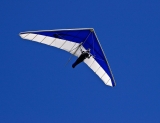
Hang gliders are devices built with a single purpose: to glide through the air without a motor to enjoy a unique flight. Air currents being fundamental, following the principles of aeronautics, for this sport to be possible, an expert pilot can fly hang gliding for a long period of time and depending on his control, until performing stunts. In fact, today, the most modern hang gliders can fly up to more than 800 km away!
If its operation does not have too many mysteries (although be careful, do not underestimate the control that must be had over them), the components of the delta wing are key for its flight to be effective. These are made up of:
- Main post. This is the tube that is between the wings of the hang glider, as if it were its spine, which makes it a solid structure that does not destabilize.
- Sail. Special fabric surface that covers the wings of the hang glider. Its material is strong and resists drafts; in fact, it is protected from ultraviolet rays with some type of protective film such as TiO2.
- Botavara. Tube similar to a tail whose functions are two: to provide even more support to the main post and to be the "aileron" that stabilizes the flight of the hang glider.
- Brow. Intersection where the two wings connect. Its shape is similar to the arrowhead in order to ensure that the air is distributed more equally in the two wings and thus make them more stable.
- Suspension point. Here goes the hang glider pilot during the journey, holding on to it.
- Tensor. Cable that serves to level the weight of the pilot with that of the hang glider itself.

- Rigging cables. They are at the top of the device allowing it to glide during flight according to the laws of aerodynamics.
- Wing cables.They are connected to the cables of the rig and are responsible for cutting off the air so that it flows through the sail and makes it fly more easily.
- Posterior edges. They are on the sides of the hang glider and on the sail. It basically serves to protect the latter during flight and to prevent it from moving uncontrollably due to the force of the wind.
- Pin sets pressure. All the material used to fix and join the parts of the hang glider.
- Slats. Safety tie-downs located under the wings and are only used in emergency cases.
- Harness system. Safety system that also connects the pilot with the delta wing tensioner so that the person is suspended during the flight.
But without a doubt, it's no use telling you how cool hang gliders are if you don't dare to try a flight on one of them. Luckily for you, in Spain you can fly hang gliding with an expert to live that unique experience. Click here to find out where you can try unrepeatable unpowered flight.













